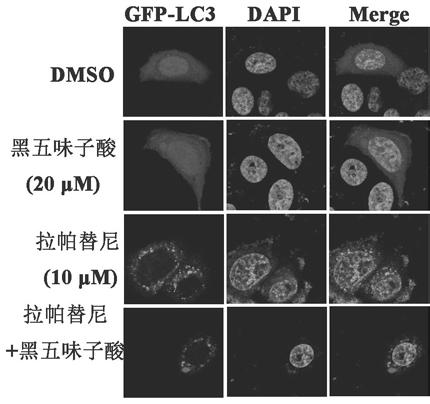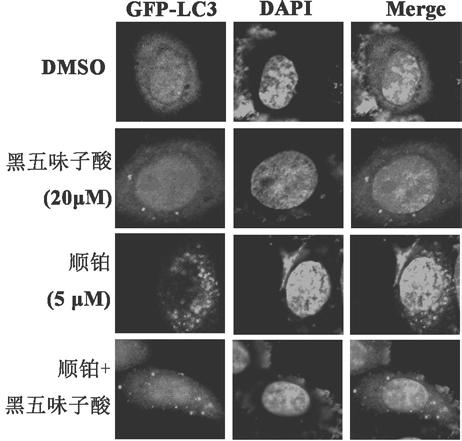Application of 3, 4-broken cycloartane type triterpenoid compound in preparation of autophagy inhibitors and antitumor drugs
A cycloaltin-type, anti-tumor drug technology, applied in the field of medicine, achieves the effects of diversified dosage forms and administration methods, broad clinical application prospects, and increased sensitivity
- Summary
- Abstract
- Description
- Claims
- Application Information
AI Technical Summary
Problems solved by technology
Method used
Image
Examples
Embodiment 1
[0054] The 3,4-cleaved cycloaltin-type triterpenoid black schisandralic acid inhibits ubiquitination of the autophagy receptor p62.
[0055] (1) Detection of p62 ubiquitination in vitro: ATP, HA-Ub, E1 ubiquitin activating enzyme UbE1, E2 ubiquitin conjugating enzyme UbcH5b, E3 ubiquitin ligase HECTD3 and its substrate were sequentially added to the reaction buffer. For p62 (with His tag), black schisandraic acid of different concentrations (5 μM, 10 μM, 20 μM) was added, DMSO was added as a positive control, and ATP was not added as a negative control, and reacted at 37°C for 40 minutes. Afterwards, it was incubated overnight with a nickel column, and after sufficient elution, the ubiquitination of p62 was detected by Western Blot.
[0056] The result is as Figure 1A As shown, compared with the negative control and positive control, 20 μM black schisandraic acid significantly inhibited the ubiquitination of p62.
[0057] (2) Detection of p62 ubiquitination in cells: p62-Fla...
Embodiment 2
[0060] The 3,4-cleaved cycloaltin-type triterpenoid black schisandralic acid inhibits lapatinib-induced autophagy.
[0061] (1) Inoculate MDA-MB-468 cells at a density of 8000 cells / well in a 24-well culture plate with glass slides placed in advance. After the cells are completely adhered to the wall, transfect the GFP-LC3 plasmid, and add lapatidine 24 hours later. Ni (10 μM), black schisandrin (20 μM) and the combination of the two (10 μM lapatinib and 20 μM black schisandrin) were treated for 4 hours (DMSO was also used as a control group), and fixed with 4% paraformaldehyde for 1 hour , soaked slides in PBS for 3 times, then sealed with DAPI-containing blocking solution, and finally observed GFP-LC3 fluorescent spots under a fluorescence microscope, and quantitatively calculated the number of GFP-LC3 fluorescent spots.
[0062] See the experimental results Figure 2A with 2B , it can be seen from the figure that the number of fluorescent spots in the lapatinib treatment ...
Embodiment 3
[0066] The 3,4-cleaved cycloaltin-type triterpenoid black schisandralic acid inhibits cisplatin-induced autophagy.
[0067] (1) Inoculate MDA-MB-468 cells at a density of 8000 cells / well in a 24-well culture plate with glass slides placed in advance. After the cells are completely adhered to the wall, transfect the GFP-LC3 plasmid, and add black schisandraic acid respectively after 16 hours (20μM), cisplatin (5μM) and the combination of the two (20μM black schisandralic acid and 5μM cisplatin) for 4 hours (DMSO was also used as a control group), fixed with 4% paraformaldehyde for 1 hour, and soaked in PBS The slides were sealed three times with DAPI-containing blocking solution, and finally the fluorescent spots of GFP-LC3 were observed under a fluorescence microscope, and the number of fluorescent spots of GFP-LC3 was quantitatively calculated.
[0068] See the experimental results Figure 3A with 3B , the results showed that the number of fluorescent spots in the cisplatin...
PUM
 Login to View More
Login to View More Abstract
Description
Claims
Application Information
 Login to View More
Login to View More - R&D
- Intellectual Property
- Life Sciences
- Materials
- Tech Scout
- Unparalleled Data Quality
- Higher Quality Content
- 60% Fewer Hallucinations
Browse by: Latest US Patents, China's latest patents, Technical Efficacy Thesaurus, Application Domain, Technology Topic, Popular Technical Reports.
© 2025 PatSnap. All rights reserved.Legal|Privacy policy|Modern Slavery Act Transparency Statement|Sitemap|About US| Contact US: help@patsnap.com



